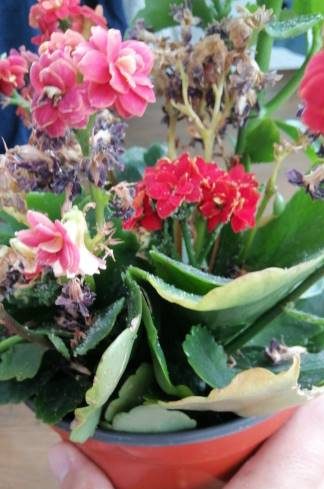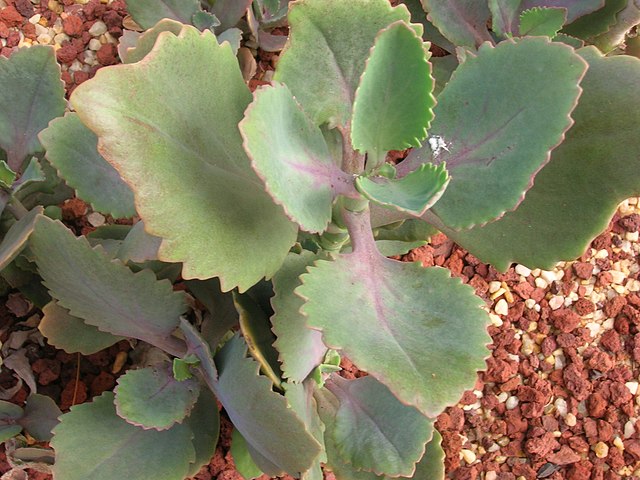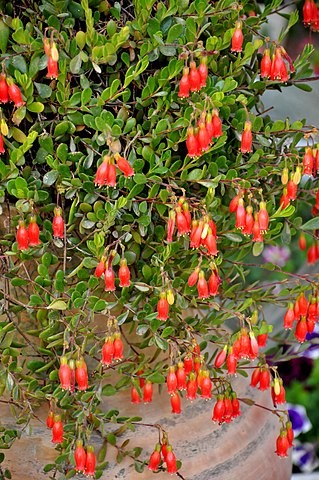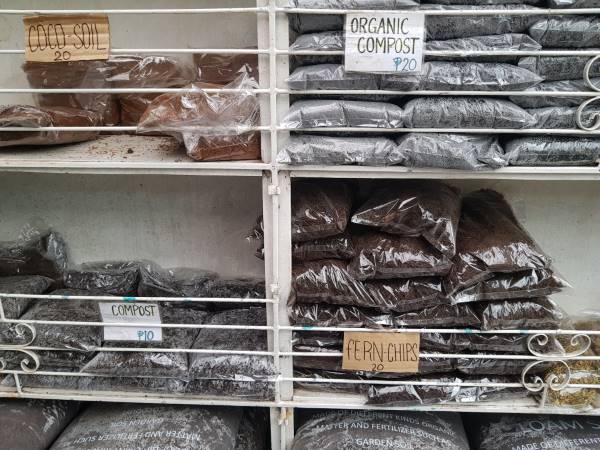Kalanchoe is amazing succulents with vivid flowers and bright shiny green leaves. It can be grown indoors and outdoors with minimal care and maintenance. If you are growing Kalanchoes indoors they might need some extra care to keep them from growing too big.
Pruning is the best way to keep your plants from growing too large and to maintain their health. Kalanchoes multiply and grow at a rapid rate, especially in the dry, frost-free environment, so you must prune the plants in time to control their spread.
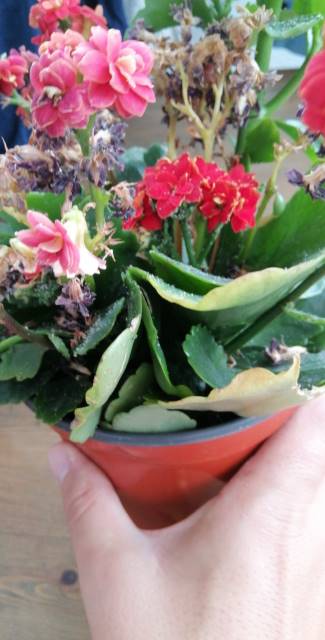
For novice gardeners or beginners, pruning might not be so easy. There are a lot of things you need to know about pruning. It’s just not about snipping off the leaves or stems. You need to know which part of the plant and how much of it you need to prune and what parts of the plants must be left alone.
Why pruning is necessary?
Pruning is an essential practice for a gardener to keep the plants healthy. It removes dead and dying branches, leaves, and stems allowing room for new growth. You might be thinking of the benefits of pruning.
Pruning offers several benefits. For indoor succulents, pruning helps to keep the plants short with dense foliage. It also helps to remove pest infestation and promotes better growth and maintains the plant’s natural shape. If you want to maintain the shape and health of your plant, you must keep pruning regularly.
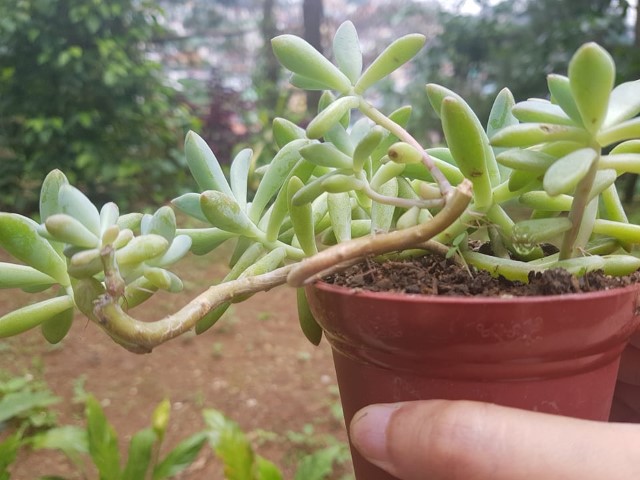
Which Kalanchoe succulent requires pruning?
Almost all the Kalanchoe species require pruning at some stage of their life. However, some of them do not require frequent or regular pruning. They do fairly well even without pruning or less pruning.
Tools required to do the pruning
For pruning kalanchoe plants you need the following simple tools.
- Sharp shears or a sharp pruning scissors
- A pair of gloves
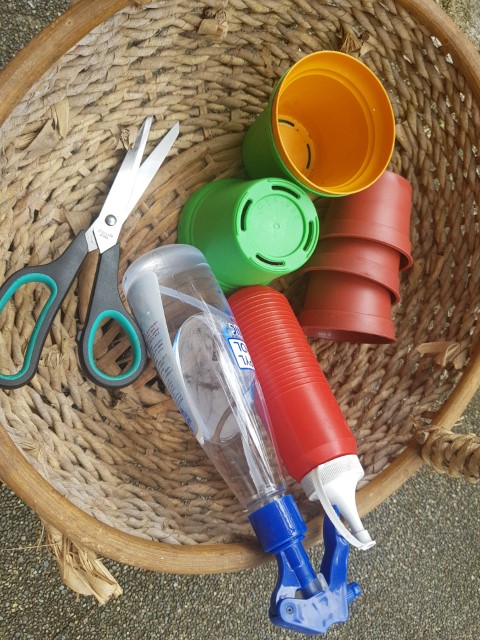
Your pruning shears must be sharp and clean to avoid any injury to the plant or to introduce a disease to a healthy growing plant. Make sure you disinfect your tools before pruning to avoid any kind of disease transmission.
How to disinfect the tools? You can use 70 % isopropyl alcohol or diluted bleach to disinfect your pruning tool. Mix 1 tablespoon of bleach in 2 cups of water. You can also make a 2 to 5 % solution of bleach for disinfection. Wipe your tools with the disinfectant or dip the tool briefly in the solution. Remove the tool and allow it to dry for some time before use.
Disinfect your tools every time you change the plant. This practice will help you to avoid the spread of any disease or pest from one plant to another plant. Wearing a pair of clean gloves will help to avoid the possible spread of disease to the plants through contaminated hands.
When to Prune?
What is the right time to do pruning of Kalanchoe succulent? These plants bloom from the end of winter to late spring season. Kalanchoe plants require short days for blooming, they usually bloom when the days become shorter than 11 hours. They require darkness for a period of 3 to 4 months for blooming.
Pruning should be done at two stages.
1) During the blooming period
2) After the blooming period is over
Here you will find a complete guide on how to prune your plants effectively during and after the blooming season.
Pruning during the blooming phase
Pruning Kalanchoe during the blooming period is generally done to encourage new growth by removing the spent blooms. Before your start to prune your plants, gently shake the plants to get rid of any insects (ants or bees) clinging to the plants. Carefully examine the plants and find out the dead or dying plant parts.
Removal of dead or dying blooms
Look for the dead or dying blooms. Cut the dead blooms or remove the spent blooms immediately. Removal of dead blooms is necessary as it not only looks unpleasant but also hinders the growth of new blooms.
You can either remove the dead blooms gently with your fingers or cut them off using standard pruning shears.
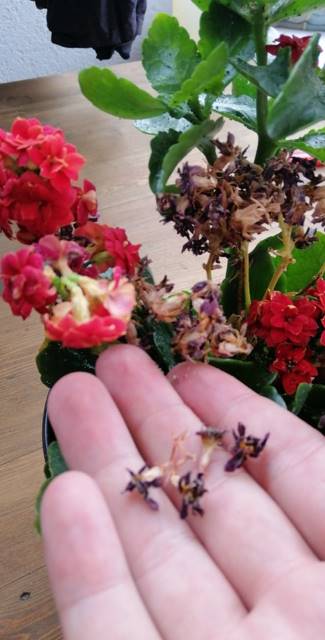
Cutting back the flower stalks
After removing the spent or dead blooms cut back the flower stalks. You can use pruning shears to cut the flower stalk back to the 2nd or 3rd leaf. Dead or damaged stalks should also be removed. This practice will encourage new growth and branching to ensure that your plant grows to its fullest potential.
Removal of dead leaves and shoots
Snip off the discolored, brown decaying leaves and shoots at the base slightly above the point where the branch joins the stem. Broken, dead, or damaged leaves should also be removed following the same process.
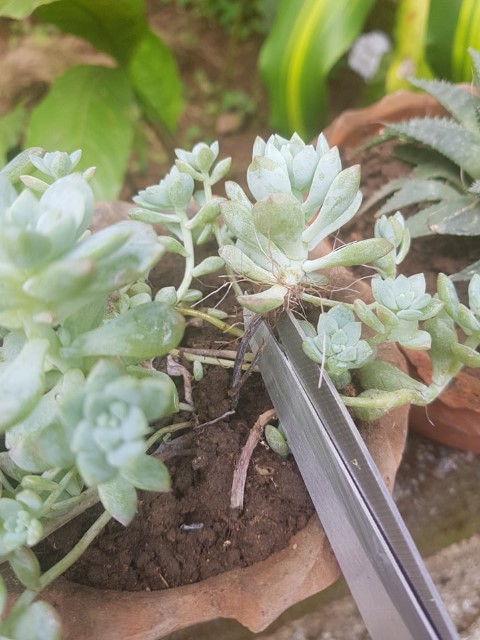
Carefully examine your plants to make sure you have removed all the dead or diseased leaves otherwise the disease might continue to spread throughout the plant or between the plants. Removal of dead or damaged foliage will keep your plant healthy and pleasant looking.
Pruning after the blooming phase is over
When the blooming season is over and the blooms start wilting or falling off, your plants are ready for pruning.
Cutting back of the tall growth after blooming
Your Kalanchoe succulent will bloom for several years, but you need to do a little more effort or care to ensure blooming for a longer time. Once the blooming period is over, and your plants finish flowering try to prune your plants immediately to remove all the flower stalks. Removal of flower stalks will reserve energy for the new growth during the next blooming season.
If your plants don’t get enough sunlight after pruning, they might start to appear stretched out, thin or weak. Try to move your plants at a location where they get ample direct sunlight for their growth.
You can also re-pot your plants in a relatively bigger container to encourage bushy growth. Then place your plants at a warm location under bright sunny daylight.
Removal of 1/3rd of each stem
After the blooming period is over, pruning your Kalanchoes down to 1/3rd of each stem’s length is essential to promote better and healthy growing plants for the next season.
If a stem appears dead or damaged cut it down at the base to the point where the branch joins the stem. Always keep an eye on the overall physical appearance and shape of the plants.
Cutting of ½ of a leaf node
Look for a leaf node that is pointed in the direction where you want the stem to grow. Snip off the stem at that point at a 45-degree angle. The new growth will be projected in the direction of that leaf node.
Repotting
Repot your succulent or prune the roots if necessary. As most of the Kalanchoes are slow-growing plants they can survive in the same pot for many years. If you want your Kalanchoe succulent to bloom for years you must transfer your plants to bigger pots.
Pruning of roots
If the roots are overgrowing the soil surface or the container trimming of the roots becomes necessary. You should prune the roots of your plants to adjust their size according to the container. Just carefully remove the plant without causing any damage to the roots and prune the roots as desired. Don’t cut the roots more than required. Trimming the roots more than the required part might affect the overall health of your plant.
Things you should do after pruning
Once you have completed pruning your plants discard all the cuttings (stems, leaves, stalks or flowers) immediately. If you leave the cuttings unattended it may attract unwanted insect pests, fungi, or bacteria.
Some varieties of kalanchoes can easily root from small pieces of the plants or dropped leaves on the surface of the earth if they find favorable conditions such as light and water, so if you want to control the spreading of these plants pick up these leftover pieces and discard them properly in the trash.
Remove the pieces to keep your plants look neat and tidy. Well organized and clean plants give a pleasant appearance and add to the aesthetic value of your home gardens.How to prune your plants if you see any signs of a pest or disease?
In case you see any signs or symptoms of a pest or disease on your plants you must prune your plants carefully to avoid the spread of infection to other plants.
Carefully inspect your plants to find out if any of the plants are showing any of the following symptoms or signs.
- The physical presence of insect pests or fungal growth
- Holes created by insects at the surface of leaves
- Yellowing of veins of the leaves
Other symptoms of fungal diseases or rotting
In case you observe any of the above symptoms, remove such leaves or plant parts at priority with care to prevent the spread of pests or diseases to healthy plants. Snip off the infected leaves, flowers, or stems first, throw them away and destroy carefully. These plant pieces must be discarded far away from the healthy plants to avoid contact with them as much as possible.
Some common mistakes to avoid
Although pruning is a healthy practice to keep your plant growth optimized, you must be aware of when and how to do the pruning?
Pruning might seem an easy job at first glance, just grab your pruning shears and go to work. Right? It’s not always the case!
If you do the pruning in the right way it will help to boost the health and growth of the plants, but if you do it in a hurry, it can also cause damage to the plants.
A few mistakes you must avoid.
- Always prune your plants when it is actually needed. Over pruning at any time of the year when it is not required can cause stress or damage to your plants.
- Pruning without a goal is not recommended at all. You should always have a goal while pruning your plants such as “pruning with a goal to remove dead or infected plant parts”.
- Excessive pruning should be avoided. Pruning every week or month will bring stress to the plants.
- Cut your plants properly and do not hurry. Proper cutting reduces the risk of damage and allows the plant to recover soon. Improper cutting may lead to large wounds or injuries and irreversible damage to the plants.
- Avoid heavy pruning during the growing season as it can increase the risk of starving the plant by removing too many leaves.
- Remove only dead or damaged leaves, stems, or spent blooms. Don’t remove healthy plant parts.
- Pruning with dull tools should be avoided. Most of us don’t think of sharpening our tools as it doesn’t seem like a big issue. However, pruning with unsharpened tools can create improper or rough cuts causing large injuries or wounds. So always keep your tools sharpened.

